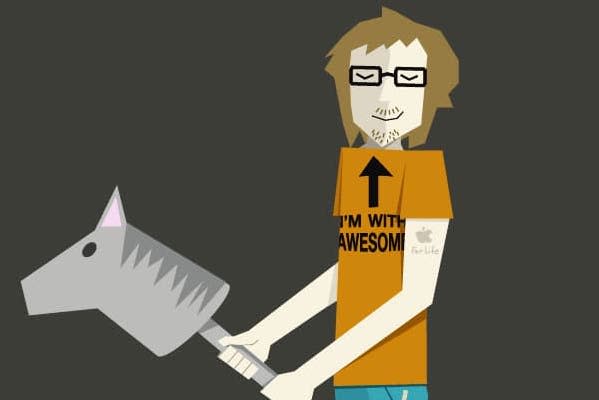There are two groups of designers that can afford to work from atop their high horse: those who have typefaces and schools named after them and those that live in their parents’ basement.
In other words, unless you are design royalty with Fortune 100 companies clamoring to have the privilege of your services, you can’t be a complete snob about your design work. If you insist on letting your ego rule the day, call Mom and Dad and tell them you’re moving in, because you won’t have a job.
Here We Are
Before I go too far, let me define terms. Design is a verb. I know we’re all guilty of using it as a noun (myself included), but it truly isn’t. In my thinking, design is the decision-making process of applying visual elements and principles to achieve a solution product. When a designer lets their personal style and preferences drive a solution, rather than the needs of a project, that is design ego on display. It is selfish, immature, and a disservice to both client and project.
Sadly, it really is an easy habit to form. It generally begins with the way we’re taught.
There are dozens of different types of designers, but for the purpose of this article, I’ll just speak to roles generically categorized as “graphic designers.” We pretty much all start out in the art world. We were the kids drawing on the back of our spelling tests. We tolerated Algebra II only because we knew that Advanced Drawing came next period. We developed our craft and eye by expressing ourselves artistically. And that’s okay; it’s what art is all about.
We found out that people were moved by what we could do. The things we did had immediate response and gratification. Our work made us stand out. We learned very quickly that few could do what we could do. Our work became part of our identity.
Insert Ego, Mr. Freud
The problem really arises when we cross over from the art world to the design world. The design world is born out of necessity, not personality. Function is the point, form is the method. Our projects are governed by goals, requirements, constraints, context, and a return on investment. The designer that has not matured past their foundational artistic days of self-focused expression lacks the humility and perspective to truly serve the needs of the project.
Now, all this isn’t to say we are to be gutless and roll over for a client’s bad design direction. We do promise our clients that we will make them look better than they’ve been able to visualize themselves. It is our role to help move them to see what could be. But at the end of the day, it is their brand. It is their blood, sweat, and skin in the game. Do not make the mistake of trivializing your client’s knowledge and experience of their industry and brand.
Yes, they asked you to help them communicate who they are, but do not mistake their vulnerable posture as license to insert personal preference and let opinions fly. Talk to them. And for goodness sake, take out your earbuds for an hour to listen to them. It is their livelihood on the line—not your portfolio.
And This Matters Because
This isn’t just a rant or pet peeve. It’s a real problem in our industry. Good clients who’ve had bad experiences with designers too focused on their own agendas become hesitant clients for the inevitable rebound agency that picks them up. They walk in the door guarded and untrusting. They have labeled our industry as elitist and bully-ish. These clients are oftentimes harder to serve. They hold tight to the edge of the design pool for fear of getting dunked in the deep end again. These clients trust only what they consider to be safe design decisions, and the world is robbed yet again of the opportunity to see an example of a beautiful, well-designed solution.
Professionals, you need to hear this for the client’s sake, but your work colleagues may be secretly hoping you’ll learn this as well. How is your working relationship with account and project managers—tense most of the time? That may be a very good sign that your arrogance is an issue. In your design reviews, can you hear crickets? Is the only one speaking up your director? It’s probably because your ego has crowded the room and left no space for other opinions. Do you no longer even hold design reviews? Look up. There’s a big neon sign above your head flashing “pompous jerk.”
Come on. Don’t be that guy/gal.
Students and young pros, you definitely need to hear this. If you want a job, agency owners already get these concepts. That’s why they own a shop that hasn’t tanked. And they can smell your arrogance from a mile away. Unless they are up for the challenge of breaking you or covering for you until you (hopefully) mature out of it, they won’t hire you.
The good news is that it is a maturity thing. Unless you really hold tight to your old ways, you can grow out of it. “Knowing is half the battle,” according to G.I. Joe. Consider yourself knowledge bombed.
Have a little humility. Hold on to personal style loosely. Prioritize your clients’ project needs first. This is the discipline of a true designer.

